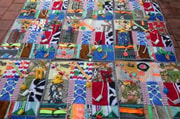Question 1: Which planet is closest in size to Earth?
Question 2: When was the Caesar salad invented?
The Caesar salad was invented by Italian-American restaurateur Caesar Cardini in Tijuana, Mexico in 1924. According to the story, Cardini improvised the dish with the ingredients he had on hand when his restaurant was busy on the 4th of July.
Question 3: In which city would you find the famous Sagrada Familia church?
The Sagrada Familia is a large unfinished Roman Catholic minor basilica in Barcelona, Spain, designed by Antoni Gaudí. Construction began in 1882 and is expected to be completed around 2026, a century after Gaudí's death.
Question 4: How many muscles are there in the human body?
There are over 600 muscles in the human body. These muscles make up roughly half of a person's body weight and are responsible for functions like maintaining posture, moving the body, and even regulating bodily functions like digestion and circulation.
Question 5: Which country is credited with the invention of pizza?
While flatbreads with toppings were consumed in ancient civilizations, modern pizza as we know it today is believed to have originated in Italy, specifically in Naples during the 18th or early 19th century.
Question 6: How many sides does a dodecagon have?
A dodecagon is a twelve-sided polygon. The term comes from the Greek words "dodeka" for twelve, and "gonia" for angle.
Question 7: Who designed the iconic Guggenheim Museum in New York City?
The Solomon R. Guggenheim Museum in New York City was designed by the renowned American architect Frank Lloyd Wright. The museum, with its distinctive spiral design, opened in 1959 and is considered one of Wright's most important works.
Question 8: Where did the Chernobyl nuclear disaster occur in 1986?
The Chernobyl nuclear disaster occurred on April 26, 1986, at the Chernobyl Nuclear Power Plant in what is now Ukraine. At the time, Ukraine was part of the Soviet Union. The disaster is considered the worst nuclear accident in history.
Question 9: What philosophical concept did Plato introduce in his famous "Allegory of the Cave"?
In Plato's "Allegory of the Cave", he introduces his Theory of Forms, which suggests that the physical world is not the ultimate reality, but rather a mere shadow of the true, eternal forms that exist in the realm of ideas.
Question 10: In Christianity, what is the season of preparation for Easter called?
Lent is a period of 40 days which comes before Easter in the Christian calendar. It's dedicted to fasting, repentance, moderation, and spiritual discipline to prepare for Easter. Lent traditionally represents the 40 days Jesus spent fasting in the wilderness.






Venus is often called Earth's "sister planet" due to their similar size, mass, proximity to the Sun, and bulk composition. It is also similar in size to Earth; Venus is only slightly smaller, with around 95% of Earth's diameter and 80% of Earth's mass.